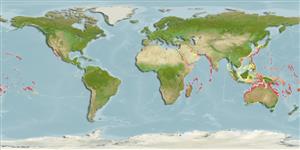Environment: milieu / climate zone / depth range / distribution range
Οικολογία
Θαλασσινό(ά) βενθικό(ς); εύρος βάθους 3 - 30 m (Ref. 59137). Subtropical
Indo-Pacific: Known from the Gulf of Aqaba, Comoro Islands and Mauritius to southern Japan, the Philippines, Caroline Islands, northeastern Australia, New Caledonia, Fiji, Tonga, American Samoa and the Society Islands.
Μέγεθος / Βάρος / Age
Maturity: Lm ? range ? - ? cm
Max length : 6.6 cm SL αρσενικό/απροσδιόριστο; (Ref. 59137)
Found frequently on coral sand (Ref. 59137).
Life cycle and mating behavior
Maturities | Αναπαραγωγή | Spawnings | Egg(s) | Fecundities | Προνύμφες
Knapp, L.W., H. Imamura and M. Sakashita, 2000. Onigocia bimaculata, a new species of flathead fish (Scorpaeniformes: Platycephalidae) from Indo-Pacific. J.L.B. Smith Inst. Ichthyol. Spec. Publ. 64:1-9. (Ref. 59137)
IUCN Red List Status (Ref. 130435)
Threat to humans
Harmless
Human uses
Εργαλεία
Special reports
Download XML
Διαδικτυακές πηγές
Estimates based on models
Preferred temperature (Ref.
123201): 24 - 29.3, mean 27.7 °C (based on 1499 cells).
Phylogenetic diversity index (Ref.
82804): PD
50 = 0.5039 [Uniqueness, from 0.5 = low to 2.0 = high].
Bayesian length-weight: a=0.01000 (0.00244 - 0.04107), b=3.04 (2.81 - 3.27), in cm total length, based on all LWR estimates for this body shape (Ref.
93245).
Τροφικό Επίπεδο (Ref.
69278): 3.4 ±0.6 se; based on size and trophs of closest relatives
Ελαστικότητα (Ref.
120179): Υψηλό, ελάχιστος χρόνος για διπλασιασμό πληθυσμού < 15 μήνες (Preliminary K or Fecundity.).
Fishing Vulnerability (Ref.
59153): Low vulnerability (10 of 100).
